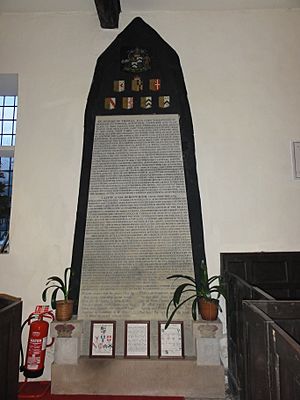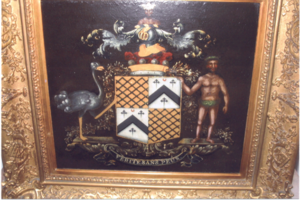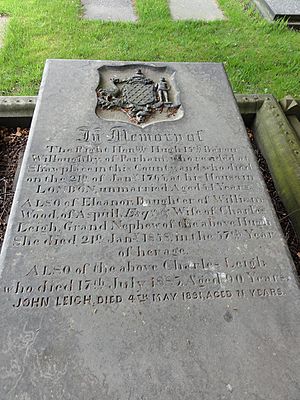Hugh Willoughby, 15th Baron Willoughby of Parham facts for kids
Quick facts for kids
Hugh Willoughby
15th Baron Willoughby of Parham |
|
|---|---|
| Born | 1713 |
| Died | 17 January 1765 London |
| Resting place | Horwich Parish Church |
| Title | Baron Willoughby of Parham |
| Tenure | 1715–1765 |
| Parents | Charles Willoughby, 14th Baron Willoughby of Parham and Hester Devonport |
|
|
|
Hugh Willoughby (1713 – 17 January 1765) was an important English nobleman. He held the title of the 15th Baron Willoughby of Parham. This meant he was a hereditary peer and could sit in the House of Lords. The House of Lords is part of the British Parliament.
Hugh was born in 1713. He was the oldest son of Charles Willoughby, the 14th Baron, and Hester Davenport. His father passed away when Hugh was very young, in 1715. This made Hugh the 15th Baron Willoughby of Parham. However, he had to wait until he was 21 years old to join the House of Lords.
Early Life and Education
Hugh Willoughby was born in Lancashire, England, around 1711. After his father's death, his mother and Reverend John Walker became his guardians. Reverend Walker was a Presbyterian minister. In 1717, Hugh's mother remarried. Because of his father's will, she could no longer be his guardian.
Hugh started school at Rivington Grammar School in 1717. This school had been recently rebuilt. It was run by non-conformists, meaning people who did not follow the official Church of England. Hugh also attended the Rivington Unitarian Chapel.
Later, Hugh moved to a non-conformist school in Taunton, Somerset. There, he met Israel Mauduit, who became a close friend. Mauduit later became a famous writer of political pamphlets. In 1732, Hugh was given the "freedom of Dumfries" in Scotland. This was an honor given to important people.
Becoming a Baron
In 1733, another person, Henry Willoughby, claimed he should be the Baron. This led to a legal challenge over the title. The case was sent to the Chief Justice of the King's Bench. This was a very important judge at the time. Sir Philip York, who later became Lord Hardwicke, supported Hugh's claim.
While the case was being decided, Hugh traveled around Europe. His absence caused delays in the hearing. When he returned, the case was still pending.
Despite the challenge, Hugh Willoughby was officially called to the House of Lords. He took his seat on February 1, 1734. Even though his rival's petition was read to the House, Hugh was recognized as the rightful Baron.
Work in the House of Lords
In his first year, Hugh Willoughby attended every session of the House of Lords. From 1735 to 1739, he was not there as often. But after 1742, he attended without missing a single session. He became very active in his duties.
Besides his work in Parliament, Hugh held other important roles:
- He was elected Vice-President of the Royal Society in 1752. The Royal Society is a famous group for scientists.
- He became President of the Society of Antiquaries in 1754. This group studies history and old objects.
- He was also a Trustee for the British Museum.
- He served as a Commissioner on the Board of Longitude. This board worked on finding ways to measure longitude at sea.
From 1758 to 1762, he was a governor at Rivington Grammar School. He also helped start the Warrington Academy, a school that taught many subjects.
Hugh Willoughby quickly became known for his hard work in the House of Lords. He chaired a committee just one year after joining. Philip Yorke, who had supported him, said Hugh was "eminently useful." He also noted that Hugh knew a lot about how Parliament worked.
Hugh played a big part in committee work between 1739 and 1740. In 1758, he temporarily became the Chairman of Committees. This was a very important role. By November 1759, he held this position permanently until he passed away. During his life, he chaired committees 58 times. He also served on 227 special committees.
Death and Legacy
Hugh Willoughby passed away on January 22, 1765, in London. He did not have any children. Even though he was a non-conformist, he was buried at Horwich Church. His grave is now in the graveyard of the current Horwich Parish Church.
He left his title as Baron to his distant cousin, Henry Willoughby. He left some of his property to his sisters, Helen Roscoe and Elizabeth Shaw. A monument in memory of the Willoughby family stands at Rivington Unitarian Chapel. The family's special seating area, called a pew, is still there. It has its original nameplate and a beautiful wooden canopy.




